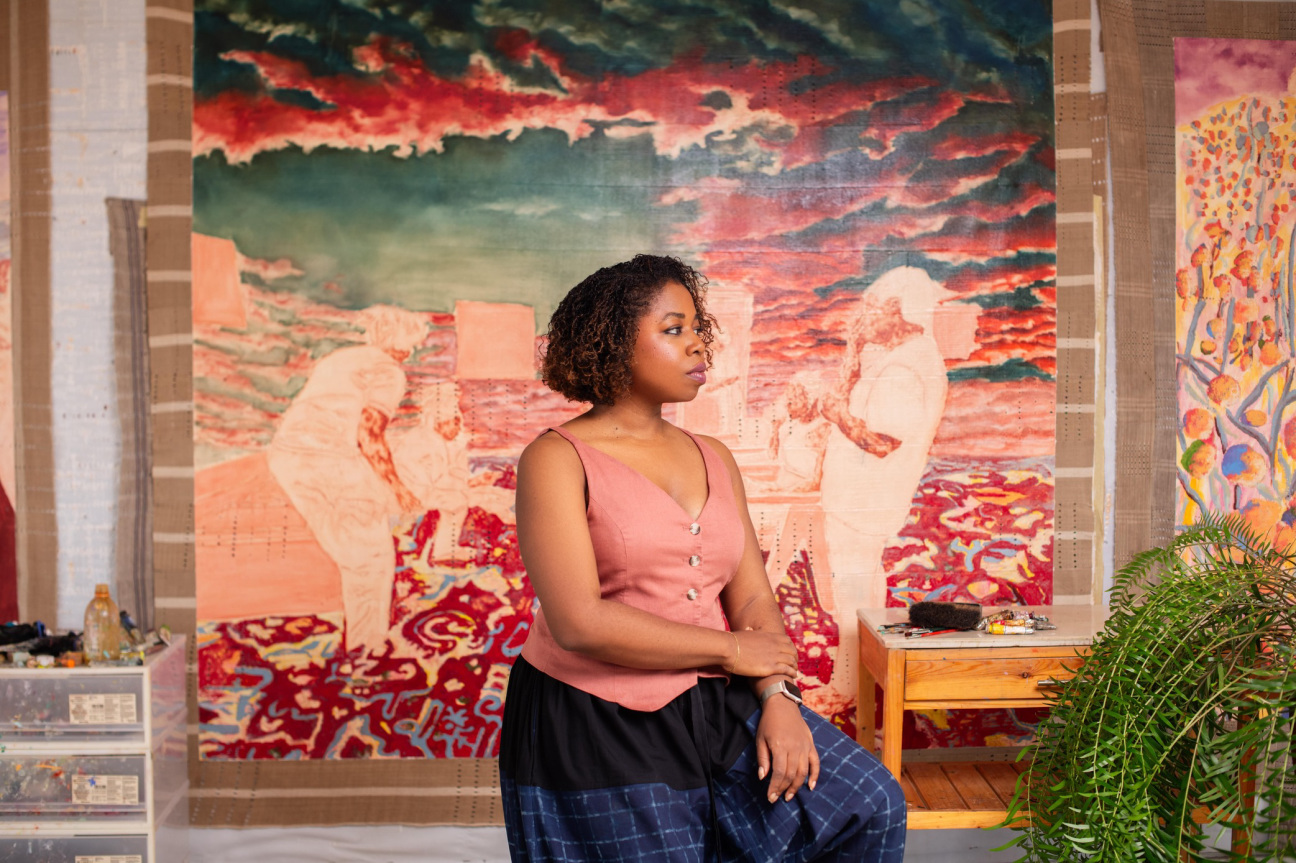
This is Close Looks: a semi-regular column from CULTURED Co-Chief Art Critics Johanna Fateman and John Vincler. This series of long-form pieces dives into both buzzy and under-the-radar shows alike, revealing the trends, ideas, and controversies that shape what’s happening—and what’s to come—in the art world.
Michelangelo’s Sistine Chapel fresco The Last Judgment came immediately to mind when looking at Nengi Omuku’s I Can’t Feel My Legs 2, 2024, in her stand-out New York solo debut exhibition, “Wild Things and Perennials,” at Kasmin Gallery. While the scale isn’t a match, there is great painterly ambition in the Nigerian-born artist’s work, as well as an attempt to render this world and a world beyond—a realm of afterlife and ancestors.
Omuku, who now lives between Lagos and London, captures, in this particular scene, bodies sitting or lying supine, as if they are recovering from a traumatic event—like an earthquake or a bombing—arrayed within a pale blue sky, with moody clouds in hues ranging from lavender to orange. In the bottom-left of the composition, someone (a child?) seems to beckon, with open arms, to the other figures, breaking the stillness of a stunned moment.
The magic of Omuku’s painting is that the figures are at once grounded and floating, compositionally more integrated into their celestial landscape than what even Michelangelo manages.
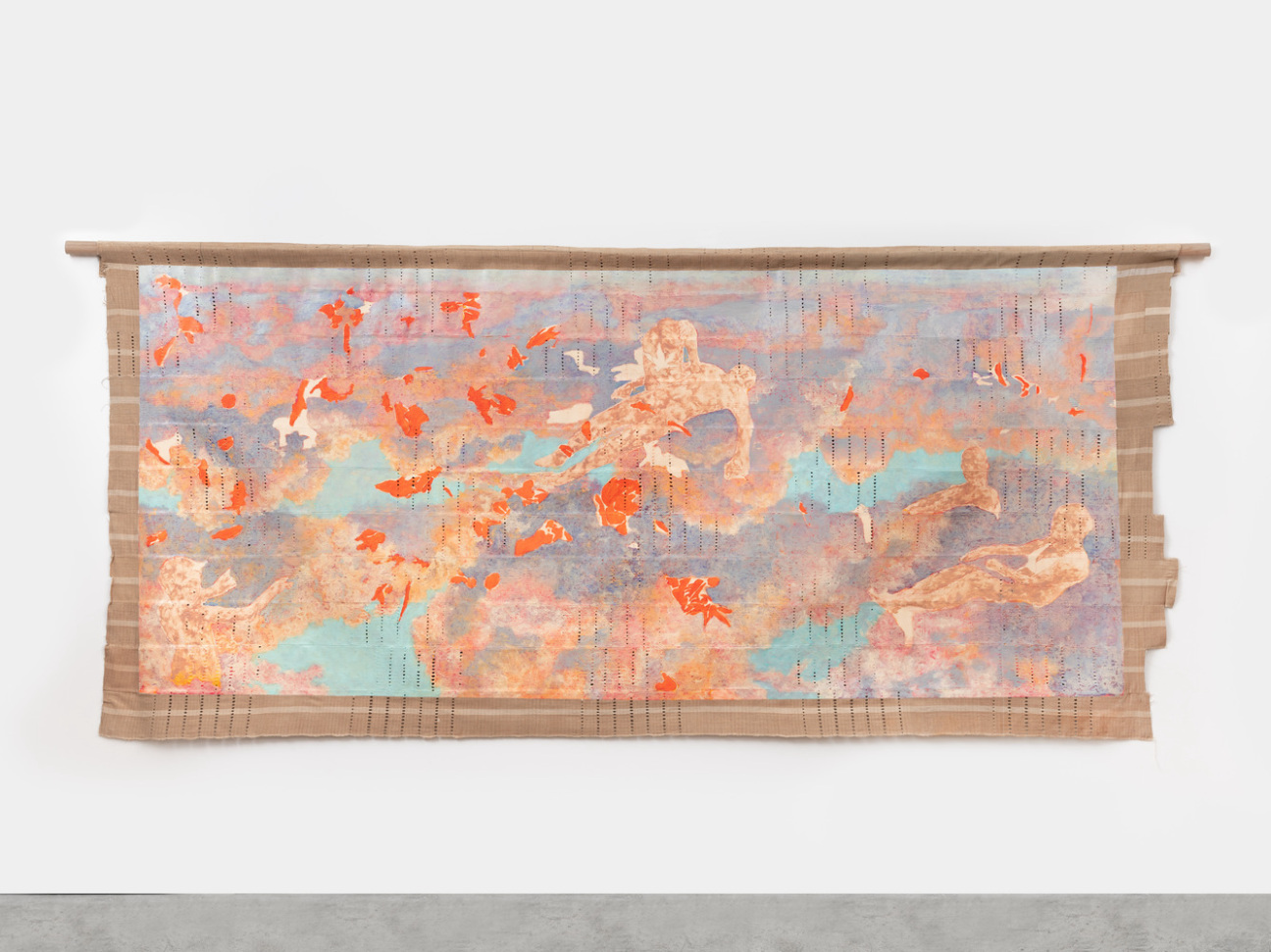
Most of the eight paintings at Kasmin are of group or crowd scenes, set in strange landscapes, where the distinctions between interior and exterior, land and sky, collapse. The themes range from protest and political crisis to the urban pastoral of the Brooklyn Botanic Garden.
Omuku paints on unstretched sanyan, a woven Yoruba textile traditionally made of silk and cotton. The striped pattern of the material (the artist uses of a mix of vintage and new fabric) is visible around the borders, as are the tiny holes, in orderly rows, that dot the surface of many of the paintings, giving them an added ethereal quality. The paintings hang from dowels suspended away from the walls of the gallery amplifying this effect.
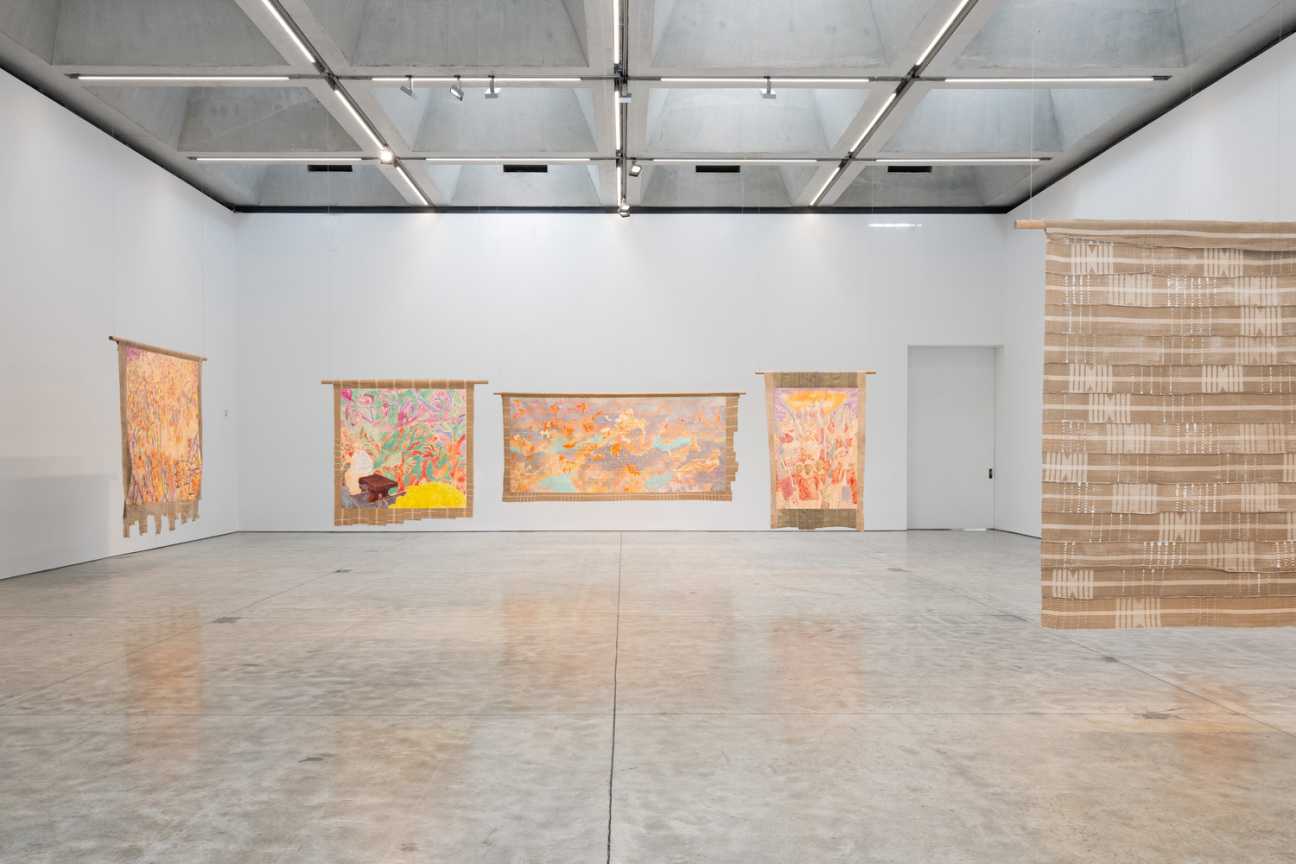
The artist’s figures often have an unfinished quality, such as a lack of defined facial features. It’s as if she has learned to stop at the very moment when her figures have just become sufficiently legible as individuals. She instinctually knows when the viewer has been given just enough descriptive information, when the vagueness of a figure transitions into the representation of a person. In tracing this limit, Omuku seems particularly interested in exploring the boundary between the individual and the collective.
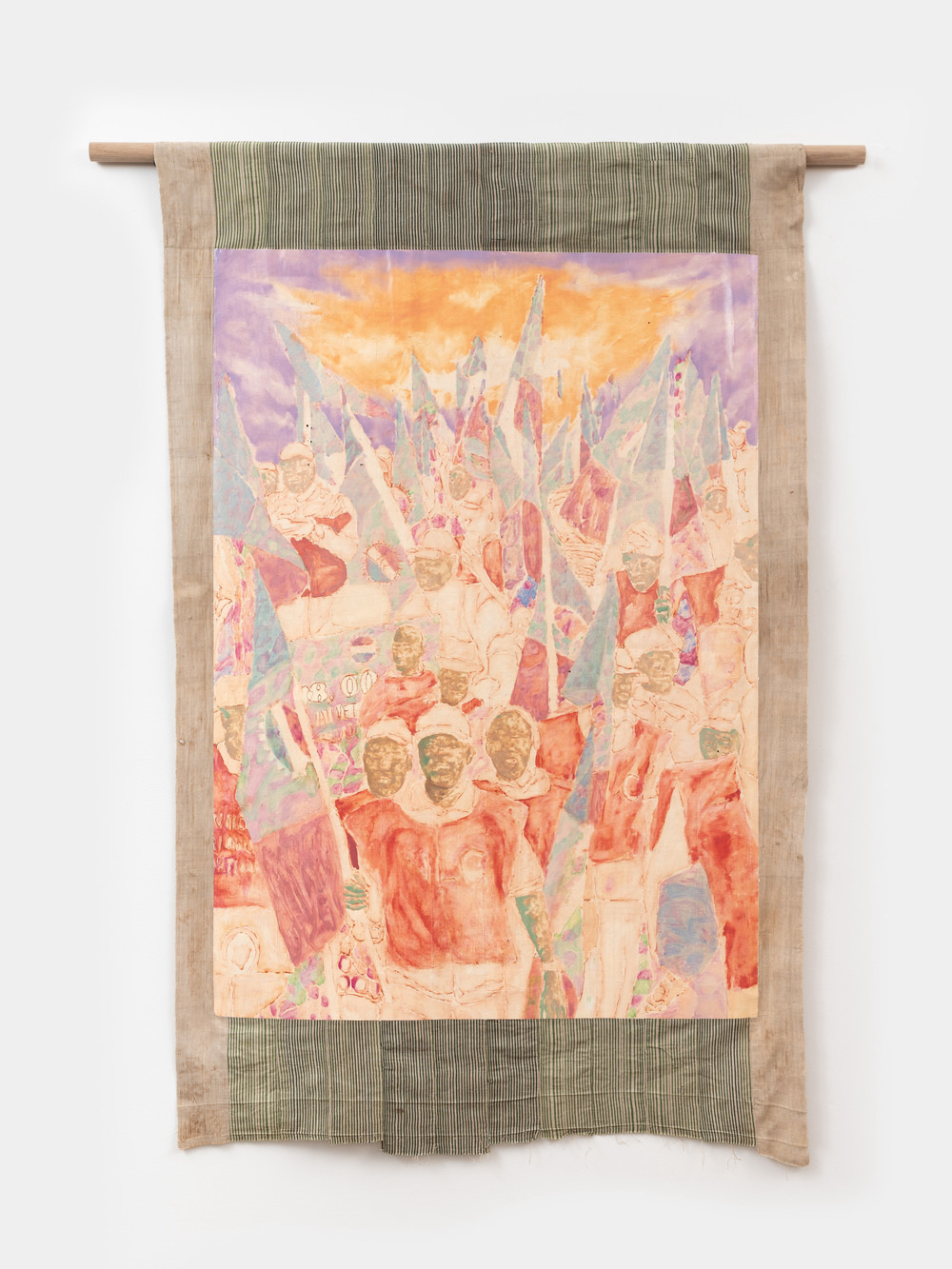
She enlivens the people in her paintings with the expressive gestures and postures of their bodies. Take for example, the protest scene of NLC, 2024, where a crowd holds up flags and marches forcefully forward toward the viewer. (The title is likely a reference to the Nigeria Labour Congress, a collective of Nigeria’s labor unions, that has frequently challenged the ruling political party. As I write this, news reports indicate an NLC leader has just been arrested.) The energy of the crowd is reflected in other choices, too. The demonstrators hold flags, which viewed from a distance collectively resemble a bouquet of flowers. Their heads, arms and hands—painted in copper tones, tinged throughout with the same green produced when that metal oxidizes—express the demonstrators force in an accumulation of minor details, like open mouths and grasping hands.
There is nothing didactic about the political undertones of her paintings. And they are all the more powerful for their openness. In this way, they recall the hauntingly ambiguous protest paintings of Thomas Eggerer, such as Corridor, 2018-20. Like Eggerer’s picture (is the scene in a stadium or a city street?), Omuku similarly makes confounding use of space, as in “Small Groups,” 2024, grounded by an elaborately painted rug, but also otherwise taking place in a field of clouds, within a room framed out only by floating parallelograms indicating windows.
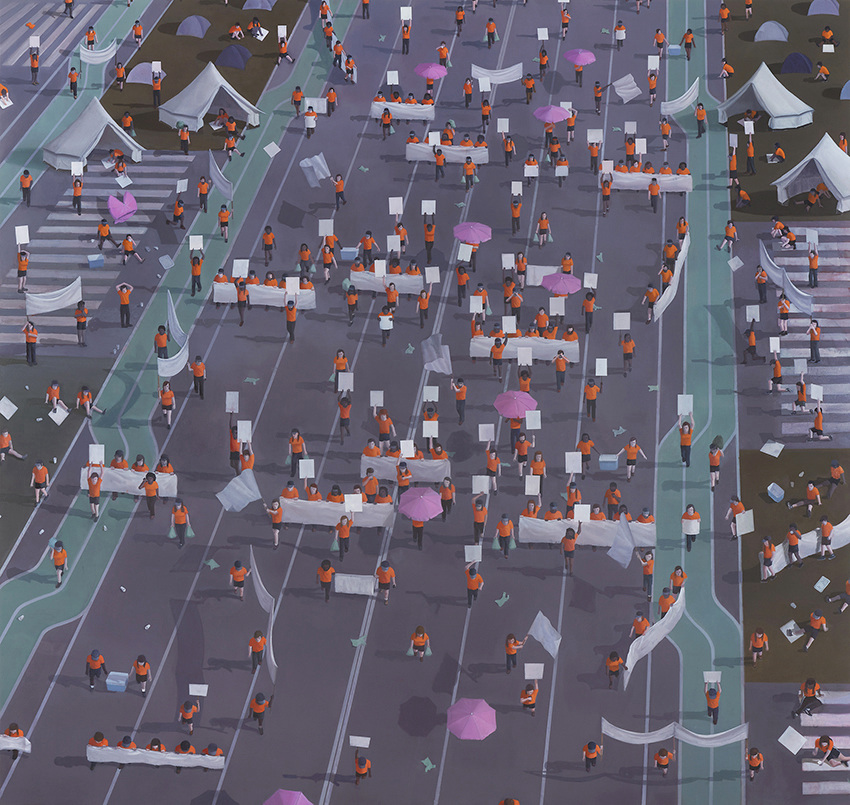
Omuku’s genius lies in her ability to present the viewer with several layers of perception: from the narrative drama of her subjects to the visual interest of the sanyan, which makes the works almost as compelling when viewed from behind as from the front—which you can readily do since the versos are left exposed. Omuku also includes an element of pure abstraction, incorporating deeply saturated colors that contrast with the pastel tones she favors to create loose patterns that dance across her surfaces. In some striking moments, large, vibrant passages, such as the deep maroon expanses in Waters Covered the Sea, 2024, recall aspects of Clyfford Still’s paintings.
The title of the exhibition, “Wild Things and Perennials” would seem to draw attention to Omuku’s treatment of flowers and plant life, as in Nneoma in Brooklyn and Orange Bougainevillea, both 2024. Landscape and flora feature more prominently in her pictures than other contemporary painters who likewise use surreal senses of space and time to highlight or tease out political undercurrents, like Maja Ruznic and Ali Banisadr (also represented by Kasmin).
But the most remarkable aspect of Omuku’s work, which she shares with these artists, is her ability to portray a collective. Seen together here, Omuku’s paintings also account for a madness inherent in contemporary life: that at the same moment one person may be attempting to enjoy a bucolic moment in a public garden, this same person may be aware of protests resulting from a contested election, or a civilian population being mercilessly bombed. The garden, the protest, and the bombing victims are all of the same world.
Although, the flags wielded by the marching NLC protesters did remind me of flowers, on second thought, the “Wild Things and Perennials” of the title might not only refer to plants. Walking through the paintings, hanging throughout the space, is not unlike walking through a garden, but the viewer is instead left to contemplate: What sort of world is it we human beings are trying to grow together anyhow? There is both beauty and hope in her portraits of togetherness.
"Wild Things and Perennials" is on view through October 24, 2024 at Kasmin's 509 West 27th Street location in New York.



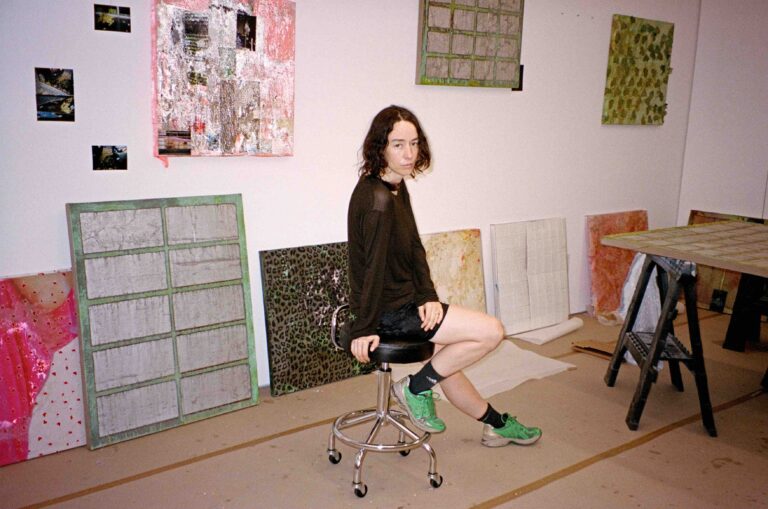


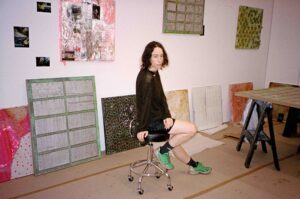



 in your life?
in your life?